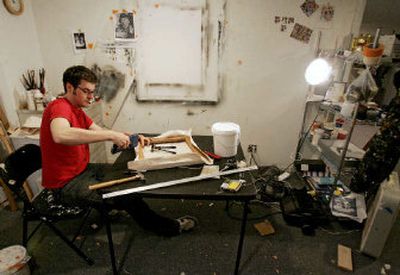Artists’ finances not a pretty picture

CHICAGO — Being a struggling artist isn’t what it used to be. In fact, it might be worse.
Andrew Falkowski thinks so, and it’s easy to understand why. The suburban Chicago resident and his wife have a combined five art degrees and six figures in debt because of them.
“Van Gogh was simply broke — he didn’t have $100,000 in debt,” said the 32-year-old Falkowski, who makes text paintings but works weekdays as a medical receptionist to make ends meet. “We all should be so lucky.”
Mostly self-employed or relying on part-time teaching jobs, many artists tend to have shaky finances and scant prospects for improving them aside from going into another profession. But some institutions have sprung up in recent years to try to help — and ideally thrive financially at the same time.
Artist Pension Trust, Creative Capital and Fractured Atlas are among the options now for artists with talent but limited wherewithal to pursue it. They offer creative workers financial education, career planning help, health insurance — even some steady income.
Persistence and patience still are required in large doses.
Cindy Bernard knows. An accomplished artist in photography and video, the Californian has received a prestigious Guggenheim Fellowship, founded and runs a nonprofit organization in Los Angeles dedicated to experimental music and has taught at Art Center College in Pasadena for six years.
But like many artists, Bernard is still just scraping by at age 47 through a combination of part-time jobs and art sales. After all, she notes, there are only so many grants out there, and that source of income eventually dries up.
“It’s an extremely marginalized realm of work,” she said. “There’s not a lot of appreciation in this country for intellectuals and artists, especially in the current political climate.”
Unlike other countries, which give artists individual grants and will pay to send them to international exhibitions, there is no direct funding for individual artists at the federal level in the United States, she noted.
Philanthropic groups and some for-profit ventures have stepped into the gap.
Both Falkowski and Bernard are among the more than 300 artists who have contributed works to Artist Pension Trust, a pension program created to provide artists with long-term financial security in exchange for their works of art.
The premise is unusual: Selected artists pool their works, contributing 20 pieces over 20 years in exchange for receiving an income stream as the trust sells the works.
APT was established 2 1/2 years ago by New York-based MutualArt Inc., an independent company formed to develop new financial service products for the art world. It has regional trusts in New York, Berlin, London, Los Angeles, Beijing and Mexico City, with more planned.
The organization also offers financial planning services for artists.
Pamela Auchincloss, director of the New York trust and managing director of global operations, says the organization fills a collective need for financial security in an industry that carries few guarantees.
“Artists often see no further than their next exhibition, which may take an entire year to produce,” she said. “While an artist who is selling regularly can feel secure that their immediate needs are met for the foreseeable future, what of a change in the tastes and interests of the collectors and curators?”
Falkowski said he had almost no guidance about money and art before he was asked to join.
“My financial future remains pretty crummy,” he said. “I joined the trust because it’s the only art institution I have seen that even implies artists can have financial grounding.”
Creative Capital, founded in 1999, tries to supply that financial grounding as it applies the model of venture capital to the arts. Artists are given seed money for their project in exchange for a percentage of any profit. Since it has a stake in the project’s success, it offers artists support services such as strategic planning and workshops in managing finances.
The New York-based nonprofit has not only given out over $6 million to 242 artists — an average of $25,000 to $35,000 per project — it has trained more than 1,000 artists in career planning, money and time management and goal-setting at its workshops.
“There’s a lot of mythology around this stuff for artists,” Ruby Lerner, the group’s founding CEO and president, said of the financial aspect. “A lot of what happens in art school is that people aren’t prepared for this. They think ‘If I’m really good, things will just come to me.’ “
Fractured Atlas, a nine-year-old nonprofit, provides a variety of support services to individual artists and arts organizations, perhaps most notably health insurance.
“Artists are really sort of boxed out of the American health care system because it’s an employment-based system and artists are usually either self-employed or it’s very short-term episodic employment,” said Adam Huttler, executive director of the New York-based organization. “You might be in a play for eight weeks, wait tables for 16 weeks, do something else for another few weeks, be on unemployment for a few weeks and then be in a play again for six weeks.”
The group’s leverage enables 2,000 artists to benefit from large group rates on health insurance coverage. It offers eight health plans, ranging from $10 a month to $400 a month.
That’s something Van Gogh didn’t have access to. He might have kept his ear.